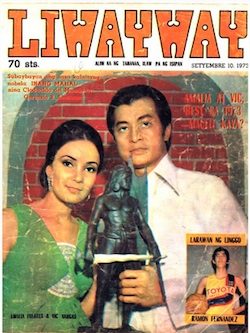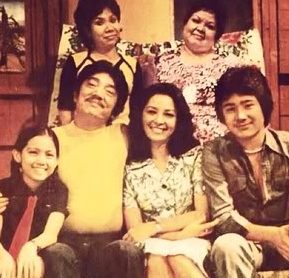SUMMARY
This is AI generated summarization, which may have errors. For context, always refer to the full article.

The phenomenal success of the long-running television noontime program Eat Bulaga’s “kalyeserye” has opened the floodgates of commonly held views on popular culture, now going viral on social media.
“Kababawan” is the most frequently hurled derogatory term at the show, and by “kababawan” is meant “shallow,” superficial,” “silly,” “no worthwhile content,” “vacuous,” “empty,” “hollow,” among other loaded terms.
In the 1950s until the 1980s, such terms as “kabakyaan,” and “kabaduyan” were the operative words that further marginalized much of popular culture – the komiks, local television, Tagalog movies, soap operas, among others – as unfit for consumption by the privileged elite and the educated middle class who were as much obsessed with their own kitsch, mostly artifacts coming straight from the West and rendered in English.
The indiscriminate usage of such terms, with their inevitable cluster of contradictory meanings and images, merely fans the flame of the ongoing and oftentimes emotional and contentious debates on “AlDub” – undoubtedly the greatest show on this side of the world, currently mesmerizing millions of people – and the show’s “value” in a nation of 100 million in the grip of poverty, corruption, and ruthless use of power.
This is not the first time that the nation has seen such a massive and hysterical outpouring of emotions of hundreds of thousands of certified fans.
Eat Bulaga stalwarts constantly refer to the number of tweets that breached the 20 million, the 30 million that has now gone over the 40 million mark. Nor can anyone fail to see the huge Philippine Arena – previously the site of the Iglesia ni Cristo gatherings – filled to the rafters, as 55,000 people followed the spectacle on the stage.
It was a colorful and almost breathless unfolding of everything that has sustained the show’s popularity – a medley of songs, jigs and dances, poetic language galore, characters in drag and their sidekicks in barong, and the ubiquitous and circuitous love story of a “yaya (nanny)” now transformed into a modern-day Cinderella and her gorgeous love (the perfect image of the mestizo as lover in this colonial society), donning the creations of famed Francis Libiran, now finally allowed to fall into each other’s arms.

Huge early successes
The 20th century is full of such rapturous response to artifacts of popular culture. When the Tagalog novel was first introduced in the Tagalog-speaking areas in the 1900s, thousands bought copies of the newspapers that serialized the novels and later, the novels in book form.
The zarzuelas of the American period attracted droves of theater-goers. And so did the bodabil of the 1930s until the 1960s with the likes of Pugo and Togo, Katy de la Cruz, Bobby Gonzales, Matimtiman Cruz, Reycard Duet, among others, doing non-stop variety show – song and dance routines, circus acts performed willy-nilly – to the delight of the crowd at Clover Theater or Manila Opera House, or some makeshift stage during town fiestas, even in the postwar years.

When Liwayway came into being in 1922, the readers took to the new magazine format – a mixture of novels, short stories, poems, and features – with enthusiasm. The likes of Fausto J. Galauran, Jose Esperanza Cruz, Teofilo Sauco, Teodoro Virrey, among others, became household names.
The Tagalog movies of the 1920s and 1930s were box-office hits, as the fans were regaled by the new technology of the moving picture. This immense popularity would continue until the 1980s, and would make the likes of Carmen Rosales, Rogelio de la Rosa, Gloria Romero, Fernando Poe Jr, Dolphy, Nora Aunor, to name a few, icons of popular culture.
In the postwar years, Don Ramon Roces further promoted the reading frenzy with the komiks and its Proteus-like ability to forever transform itself. The komiks introduced millions of readers to the adventures of Kenkoy, Bondying, Darna, Dyesebel, Roberta, Kalabog En Bosyo, Ang Panday, Maruja, Jack en Jill, Facifica Falayfay, Petrang Kabayo, the ill-starred lovers of Maruja and Bukas…Luluhod ang mga Tala, the persecuted heroine in Bituing Walang Ningning, Gilda, or Insiang, to name a few.
Radio and its new technology was introduced in the 1920s but reached the peak of popularity with the mind-boggling success of the soap opera, penned by the likes of Lina Flor and Liwayway Arceo. People would make it point to be home in time for the daily dose of stories woven in such blockbusters as Gulong ng Palad and Ilaw ng Tahanan, or Dr Ramon Selga in the 1950s.
The turns and twists in the lives of Luisa and Carding, Choleng, to name a few, held the public’s imagination in thrall, as hundreds of thousands of listeners lapped up the highs and lows of love and family life, themes that the zarzuelas, the novels and short stories, to name a few, had explored to the death!

With television offering a more intimate view of the world – visually and aurally – the public had another source of “libangan (hobby)” or “aliw (entertainment).” Dolphy and Panchito continued to regale the public with their comedic talent through Buhay Artista, and Dolphy with Nida Blanca proved a formidable couple in John en Marsha, with Dely Atay-Atayan, the immoveable force, perpetually exhorting John, “Magsumikap ka (Work harder)!” and asking the family to stay the course in the face of life’s difficulties.
Countless teleseryes, mostly based on the old soap opera or Tagalog komiks and films, returned again and again to earlier themes and motifs – unrequited love, the persecuted orphan, the hero’s quest, the formidable battle between good and evil, the need for order – dished out and shaped by a heavy reliance on the didactic tradition. The recent show, Be Careful with My Heart that featured a nanny falling in love with the master of the house (as in Jane Eyre), still leaves a glow on the faces of the teleserye’s die-hard fans.
Eat Bulaga through the years
The noontime shows, for their part, captured the younger audience; Eat Bulaga had its own unique charm years ago. These noontime shows were the modern variations of the bodabil, as earlier exemplified by German Moreno’s Sunday Extravaganza over DZRH. But along the way, Eat Bulaga had to create and test new formulas that deployed scantily clad dancers, a variety of contests, gags and lewd jokes that the program’s hosts, Tito Sotto, Vic Sotto, and Joey de Leon, and their sidekicks continually spewed out.
The knowing and oftentimes leering glances, the lecherous smirks of the hosts were trademarks of the show for years – powerful men/hosts reveling in their authority in the program as they made fun of some contestants and even members of the audience.

Indeed, the question is: how did this noontime show – which critics admitted, hardly displayed any social orientation or even sought to inculcate values, and which peddled the lie that life is a long series of running gags, underhanded compliments, frenzied pursuit of money to be had – not because of intelligence, but through sheer luck, transform itself?
The program helped instill in the minds of millions that fame could be had by someone with a handsome face and a sultry figure, or the cute demeanor of a child star. How was this program able to come up with a narrative that the Catholic Mass Media Awards recognized for instilling traditional values? How did this show, the embodiment of “kababawan,” stumble upon a magic formula that now has millions in thrall? – Rappler.com
(CONCLUSION: Part 2: The AlDub experience: Millions captivated)
The author has done research on various aspects of popular culture and has published the results of her research. She also taught interrelated courses on representations and images in popular culture as faculty of the Interdisciplinary Studies, Ateneo de Manila University.
Add a comment
How does this make you feel?
There are no comments yet. Add your comment to start the conversation.